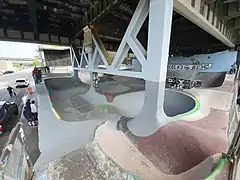Burnside Skatepark
The Burnside Skatepark is a DIY concrete skatepark located in Portland, Oregon, United States. Burnside was the first do-it-yourself concrete skatepark project and has spawned other similar projects across the globe. It is located under the east end of the Burnside Bridge. The project was started without permission from the city of Portland before being accepted as a public skatepark. Its features include many hips, pools, pyramids, and vertical sections. The skatepark is free-admission and requires no helmet, protective knee-pads, or elbow-pads. The skatepark receives no funding from the city of Portland. The park is regarded as an on-going project that is funded by donations.
| Burnside Skatepark | |
|---|---|
 The Burnside Skatepark as of May 18, 2019. Taken from the southwest corner of the skatepark. | |

| |
| Type | DIY concrete skatepark |
| Location | Burnside Bridge |
| Nearest city | Portland, Oregon |
| Coordinates | 45.522964°N 122.663555°W |
| Created | October 31, 1990 |
History

The DIY project was begun by skateboarders Rusten Muhlestein, Bret Taylor, Chuck Willis, Osage Buffalo, Kent Dahlgren, Jay Graham, and Mark "Red" Scott in the summer of 1990 by pouring concrete against Burnside's main wall, creating a vertical transition obstacle in the empty parking lot below the east-end of the Burnside bridge.[1] The skateboarders found inspiration to do so because the area was covered and protected from Portland's rainy season, allowing the park's riders to skate all year long. With a spare couple of bags of cement, the project was begun. The founders created a bank obstacle three feet by three feet in dimensions. The second obstacle created was another bank against the same wall, this time, this time with the dimensions of five by six feet. The banks were eventually merged into a single bank. The second major obstacle built was a mini bowl pocket along the north-end support beam of the bridge. Following these initial small obstacles, the founders of the DIY project struck a deal with nearby construction workers, employed by Ross Island Cement, building the I-84 on-ramp.[2] The skateboarders convinced the workers to give them leftover cement from the I-84 on-ramp construction. From then on, the project's construction exploded, with the skaters re-paving the ground of the parking lot.
Prior to the beginning of the skatepark project, the spot was known as "Hobo Camp," because of the numerous homeless people living there.[2]
In 2016, an apartment complex known as Yard was constructed west of the Burnside skatepark. There was a lot of speculation on what would happen to the park, with supporters of the skatepark creating petitions to preserve the skatepark. Ultimately, the skatepark did not experience any loss of territory, just a loss of sunlight from the building blockage. The construction of the apartment complex obstructed sunlight from the skatepark, causing Burnside to be much darker during the day. To compensate for this, Yard's chief developer agreed to install lights for the skatepark.[3]
Influence

Burnside is credited with the start of the DIY movement in the skateboarding industry. Its foundation lead to two of the largest skatepark-construction companies, Grindline Skateparks and Dreamland Skateparks, both of which have gone to build hundreds of additional skateparks across America.[4] Through the creation of Burnside, popular opinion is, it also helped to ignite the flame for the rebirth of public Skateparks in the United States. Additionally, Burnside popularized the use of poured concrete for DIY skate obstacles. Up until the park's popularization, nearly all conventional public skateparks' ramps and obstacles had been crafted out of wood and metal.
In an 2009 article the Wall Street Journal attributes Burnside as being instrumental in transforming Portland into "the skateboarding capital of the world[5]" and the site serves as a memorable landmark on the "Portland Walking Tour.[6]" In a 2018 New York Times article, Burnside is cited as one of the key reasons why "skateboarders won," and why skateparks are booming.[7]
Celebrating 30 years of continuous semi-autonomous self-governance in the fall of 2020, Burnside represents a uniquely enduring legacy that's gaining social currency among grassroots activists, and its lessons are informing the work of those working to activate local leadership in cultivating hyper-local economic revival the wake of COVID-19, lending inspiration to those outside skateboarding culture.
Uses in Media
Burnside is one of the playable levels in the video game Tony Hawk's Pro Skater and its remakes.
Burnside is used in the opening sequence of the 1993 film Free Willy.
In the book Scarred for Life, author Keith Hamm attributes Burnside with the "birth of the modern skatepark."
Burnside is used in the 2007 film Paranoia Park.[8]
References
- Willamette Week (2015-11-02), Under the Bridge: 25 Years of Fighting for Burnside Skatepark, retrieved 2019-05-13
- "Burnside History". burnsideproject.blogspot.com. Retrieved 2019-05-30.
- "Iconic Portland skate park on the front lines of gentrification". PBS NewsHour. 2016-12-24. Retrieved 2019-05-13.
- "Burnside Skatepark turns 20 on Halloween". ESPN.com. 2010-10-29. Retrieved 2019-05-30.
- Dougherty, Conor (2009-07-31). "Skateboarding Capital of the World". Wall Street Journal. ISSN 0099-9660. Retrieved 2021-01-23.
- "WSJ: Portland is Skateboarding Capital of the World". Portland Walking Tours. 2009-07-31. Retrieved 2021-01-23.
- Ihaza, Jeff (2018-04-07). "Skateboarders Won (Published 2018)". The New York Times. ISSN 0362-4331. Retrieved 2021-01-23.
- Paranoid Park (2007) - IMDb, retrieved 2021-01-23